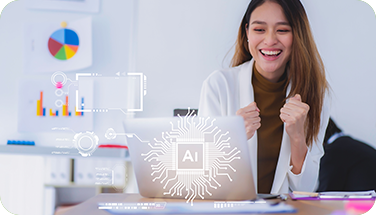Embracing the Future of Work: Customer-Centric Automation in ERP Systems
Globally, industries have increased pressure to meet changing compliance, become strategic, and navigate uncertainties, but often struggle with time-consuming manual operations.
HR and finance professionals spend up to 40% of their time on manual tasks like data entry, scheduling, and reporting, leaving little time to form strategy.

This not only affects productivity, and strategic capabilities but hampers employee satisfaction. The lack of engagement is clear, with Gallup reporting that two-thirds of the global workforce feels unengaged, leading to an estimated $7 trillion in lost productivity annually.
As a product director at Unit4, I have 10 years of experience innovating within the ERP, and the capabilities of AI and automation remain clear. I recently presented at the ERP Summit 2024 hosted by Herbert & Nathan, and in this blog I would like to share with you Unit4’s vision to utilize ERP to solve customer challenges and bring value.
Human-centric AI can improve the employee experience
When employees are engaged and satisfied, their productivity and capability for innovation increase, adding direct value to your organization. Moreover, without arduous manual tasks filling their day, the employee experience can become value-driving and strategy-building, rather than just fulfilling rote tasks.
Jacob Morgan's Employee Experience Index highlights that organizations investing in employee experience are four times more profitable than those who don't. Forbes adds that satisfied employees are more likely to contribute to innovation, fostering growth and adaptability within the company.
Yet, as AI and automation reshape job roles and skill requirements, reskilling and upskilling initiatives are essential to support the implementation process, and our HCM solution can help support this by using data to empower people managers and inform talent strategies.
By investing in AI and automation capabilities, organizations can continually improve employees’ day-to-day operations, enabling them to grow and add to the organization, not just fatigue under rote tasks that are naturally fit to be handled by AI.
How can automation help?
Automation in ERP systems has evolved from simple macros and scripting to advanced robotic process automation (RPA) that integrates AI with data to identify patterns, learn over time, and make predictions – what’s commonly known as ‘machine learning.’
An employee may simply fatigue when absorbing lots of data and undergoing repetitive tasks, which can result in data entry errors. Alternately, AI will continually enhance the process for speed, optimizing as it goes, which can reduce costs, improve compliance through accuracy, and even innovate new processes.
Unit4 is also expanding automation capabilities across other areas of its ERP, including HCM/Payroll, Projects, and Finance. Areas of focus include:
- A payroll navigator to streamline the payroll process and reduce manual corrections
- Projects resource allocation to optimize resource use and ensure timely, budget-friendly project delivery
- Automation for statement processing and a storytelling feature to explain deviations in standard reports.
At Unit4, the approach to Intelligent Automation aims not just to replace human effort but to liberate employees to use human logic where it matters, swapping manual operations for strategic analysis.
Click to read ERP product brochure Gated
Use case: Invoice Management
A practical example of this approach is Invoice Management. Traditionally, managing invoices involves manual and labor-intensive tasks that require collaboration between Accounts Payable clerks and purchase owners.
Common pain points include the time-consuming nature of the process, high error rates, and difficulties responding to supplier queries due to low visibility and multiple approval steps.
Unit4 redesigned the invoice management process by integrating with an e-invoicing platform, enhancing field recognition and prediction services, and introducing a virtual assistant to streamline approvals.
This assistant flags tasks needing attention, suggests modifications, facilitates communication, and archives conversations, leading to significant time savings and efficiency improvements.
The potential of automation to reimagine productivity in the invoice management process is huge, and Unit4 has goals to achieve:
- 50% reduction in time spent identifying issues
- 60% reduction in time spent amending invoices with errors
- 90% time savings on handling multi-client invoices
- 60% reduction in time required to respond to queries on registered invoices
These efficiencies could free up approximately two hours per day for Accounts Payable clerks, allowing them to focus on strategic tasks such as improving supplier relationships, enhancing data analysis, collaborating with other departments, and engaging in training and development.
Final Thoughts
The journey towards intelligent automation in ERP systems signifies more than just technological advancement, but a transformation in how we approach work.
As we navigate towards a future where automation and AI can help make employees’ work more meaningful, reducing the burden of manual tasks to re-focus on value-adding strategic operations, organizations can create environments that are efficient and productive but also empowering.
By embracing Unit4's integrated suite of Cloud-powered ERP solutions, organizations can harness the power of intelligent automation while enjoying seamless upgrades and access to cutting-edge innovation. Cloud migration with Unit4 ensures businesses stay agile, competitive, and prepared for future challenges.
Explore Unit4's customer-centric approach to AI on our dedicated page or visit our website to learn more about our Cloud-powered suite of integrated solutions, to embark on your journey towards a smarter, more efficient future.
Alternatively, hear my full speech on AI and automation at the 2024 ERP Summit, to understand Unit4’s customer-centric approach.





